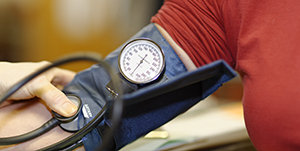
By Linda Snyder, Senior Care Advocate, Villas of Holly Brook
Having high blood pressure puts you at risk for heart disease and stroke, which are leading causes of death in the United States. About 75 million American adults (32 percent) have high blood pressure — that’s one in every three adults. Only about half (54 percent) of people with high blood pressure have their condition under control. High blood pressure was a primary or contributing cause of death for more than 410,000 Americans in 2014 — that’s more than 1,100 deaths each day.
Recently, the American Heart Association lowered the bar for hypertension (high blood pressure) from 140/90 to 130/80. These guidelines are based on the detection, prevention, management, and treatment of high blood pressure. For many Americans, this means that they are at higher risk than they once were.
If you have been diagnosed with high blood pressure, along with 75 million other Americans, your risks are even higher. According to the Centers for Disease Control (CDC), there are several lifestyle changes you can make to lower your blood pressure and keep it in a healthy range:
- Lose a few pounds. Blood pressure increases as weight increases, dropping excess weight is one of the most effective ways of gaining control.
- Exercise regularly. Consistent physical activity can help lower blood pressure and even avoid hypertension. Try walking or swimming 30 minutes a day.
- Eat healthy. Consider the “DASH” diet, which stands for Dietary Approaches to Stop Hypertension. This nutritional approach encourages consuming foods that are rich in whole grains, fruits, vegetables, and low-fat dairy products. It has been proven to decrease the risk of high blood pressure tremendously.
- Say no to sodium. According to Mayo Clinic studies, a small reduction in sodium can reduce blood pressure. Practice steps that can help include checking food labels, limiting intake of processed foods, and limiting salt intake with each meal.
High blood pressure usually has no warning signs or symptoms, so many people don’t realize they have it. There’s only one way to know whether you have high blood pressure: have a doctor or other health professional measure it. Measuring your blood pressure is quick and painless.
Blood pressure is measured using two numbers. The first number, called systolic blood pressure, represents the pressure in your blood vessels when your heart beats. The second number, called diastolic blood pressure, represents the pressure in your blood vessels when your heart rests between beats. Blood pressure is measured in millimeters of mercury (mmHg).
Reducing high blood pressure requires knowing the risk factors, symptoms, and implementation of a treatment process that may involve medication or other treatments.
Talk to your physician if you struggle with high blood pressure and together you can find a manageable solution that will help you.
This was a brief synopsis from a seminar held at the Villas of Holly Brook and Reflections Memory Care. They offer free seminars on health and memory care issues each month. The Villas of Holly Brook and Reflections Memory Care offers a full range of personalized assisted living services delivered by team members who are trained to encourage independence, preserve dignity, enable freedom of choice, and protect the privacy of residents. If you would like to schedule a personal tour and share lunch with the executive director, please call 1-855-20 VILLA (1-855-208-4552). Learn more about the Villas of Holly Brook and Reflections Memory Care online at www.villasofhollybrook.com.
